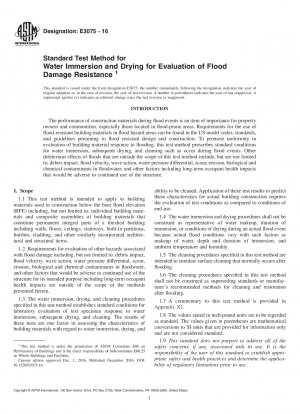ASTM E3075-16
Standard Test Method for Water Immersion and Drying for Evaluation of Flood Damage Resistance
- Standard No.
- ASTM E3075-16
- Release Date
- 2016
- Published By
- American Society for Testing and Materials (ASTM)
- Status
- Replace By
- ASTM E3075-18
- Latest
- ASTM E3075-18
- Scope
- 1.1 This test method is intended to apply to building materials used in construction below the base flood elevation (BFE) including, but not limited to: individual building materials and composite assemblies of building materials that constitute permanent integral parts of a finished building including walls, floors, ceilings, stairways, built-in partitions, finishes, cladding, and other similarly incorporated architectural and structural items. 1.2 Requirements for evaluation of other hazards associated with flood damage including, but not limited to: debris impact, flood velocity, wave action, water pressure differential, scour, erosion, biological and chemical contaminants in floodwater, and other factors that would be adverse to continued use of the structure for its intended purpose including long-term occupant health impacts are outside of the scope of the methods presented herein. 1.3 The water immersion, drying, and cleaning procedures specified in this test method establishes standard conditions for laboratory evaluation of test specimen response to water immersion, subsequent drying, and cleaning. The results of these tests are one factor in assessing the characteristics of building materials with regard to water immersion, drying, and ability to be cleaned. Application of these test results to predict these characteristics for actual building construction requires the evaluation of test conditions as compared to conditions of end-use. 1.4 The water immersion and drying procedures shall not be construed as representative of water makeup, duration of immersion, or conditions of drying during an actual flood event because actual flood conditions vary with such factors as makeup of water, depth and duration of immersion, and ambient temperature and humidity. 1.5 The cleaning procedures specified in this test method are intended to simulate surface cleaning that normally occurs after flooding. 1.6 The cleaning procedures specified in this test method shall not be construed as superseding standards or manufacturer’s recommended methods for cleaning and restoration after flooding. 1.7 A commentary to this test method is provided in Appendix X1. 1.8 The values stated in inch-pound units are to be regarded as standard. The values given in parentheses are mathematical conversions to SI units that are provided for information only and are not considered standard. 1.9 This standard does not purport to address all of the safety concerns, if any, associated with its use. It is the responsibility of the user of this standard to establish appropriate safety and health practices and determine the applicability of regulatory limitations prior to use. 1 This test method is under the jurisdiction of ASTM Committee E06 on Performance of Buildings and is the direct responsibility of Subcommittee E06.25 on Whole Buildings and Facilities. Current edition approved Dec. 1, 2016. Published December 2016. DOI: 10.1520/E3075-16. Copyright © ASTM International, 100 Barr Harbor Drive, PO Box C700, West Conshohocken, PA 19428-2959. United States 1 2. Referenced Documents
ASTM E3075-16 Referenced Document
- ANSI/IICRC S500 IICRC S500 Standard and Reference Guide for Professional Water Damage Restoration*, 2024-04-21 Update
- ASTM D7789 Standard Practice for Collection of Fungal Material from Surfaces by Swab*, 2021-11-01 Update
ASTM E3075-16 history
- 2018 ASTM E3075-18 Standard Test Method for Water Immersion and Drying for Evaluation of Flood Damage Resistance
- 2016 ASTM E3075-16 Standard Test Method for Water Immersion and Drying for Evaluation of Flood Damage Resistance
